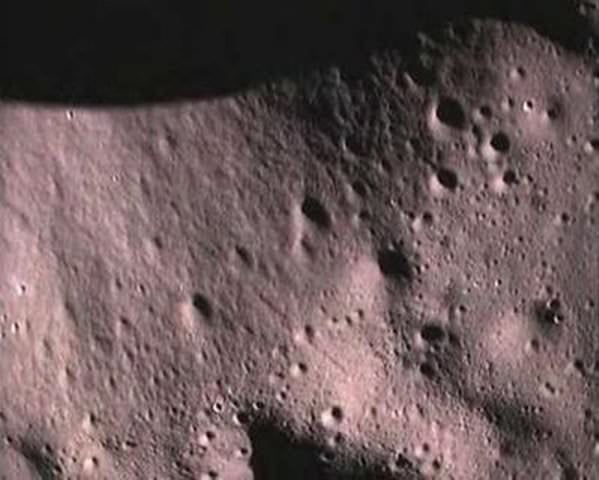Image from the Moon Impact Probe of the lunar surface. Credit: ISRO
A website based in India has reported researchers with the Chandrayaan-1 mission may have found "signs of life in some form or the other on the Moon."
DNAIndia.com
quoted Surendra Pal, associate director of the Indian Space Research Organization (ISRO) Satellite Centre as saying that Chandrayaan-1 picked up signatures of organic matter on parts of the Moon's surface. "The findings are being analyzed and scrutinized for validation by ISRO scientists and peer reviewers," Pal said.
Sources in India say Chandrayaan project director M. Annadurai later commented that the story was broken very prematurely. However, he did not dismiss the idea.
At a press conference Tuesday at the American Geophysical Union fall conference, scientists from NASA's Lunar Reconnaissance Orbiter also hinted at possible organics locked away in the lunar regolith. When asked directly about the Chandrayaan-1 claim of finding life on the Moon, NASA's chief lunar scientist, Mike Wargo, certainly did not dismiss the idea either but said, "It is an intriguing suggestion, and we are certainly very interested in learning more of their results."
Chandrayaan-1's Moon Impact Probe, or MIP impacted the within the Shackleton Crater on the Moon's south pole on Nov. 14, 2008. An anonymous Chandrayaan-1 scientist said MIP's mass spectrometer detected chemical signatures of organic matter in the soil kicked up by the impact.
"Certain atomic numbers were observed that indicated the presence of carbon components. This indicates the possibility of the presence of organic matter (on the Moon)," a senior scientist told DNAIndia.
The scientist added the source of the organics could be comets or meteorites which have deposited the matter on the Moon's surface but the recent discovery by another impact probe -- the LCROSS mission -- of ice in the polar regions of the Moon also "lend credence to the possibility of organic matter there."
Undoubtedly, getting from carbon compounds directly to organics is a bit of a stretch, but amino acids have been detected in comets and
were also found in pieces of the asteroid 2008 TC3
that landed in Africa over a year ago. Over the millennia, the Moon has been bombarded by comet and asteroid hits.
We'll keep you posted on any official announcements by ISRO.
Sources: BAUT Forum,
DNA India,
AGU press conference
 Universe Today
Universe Today
